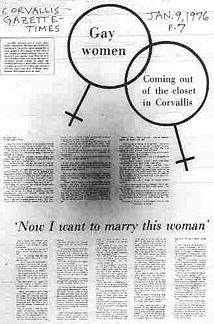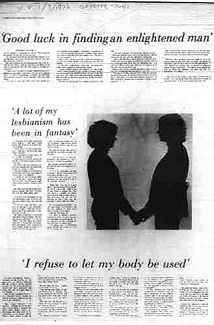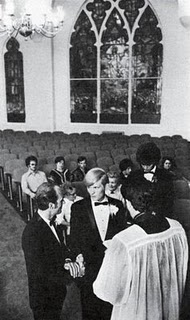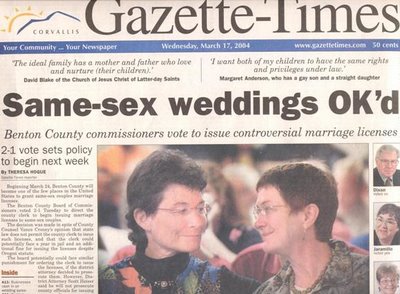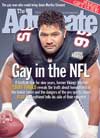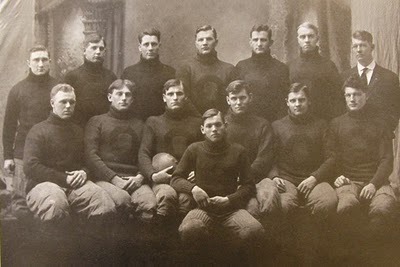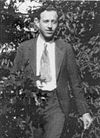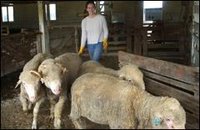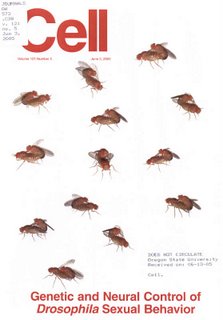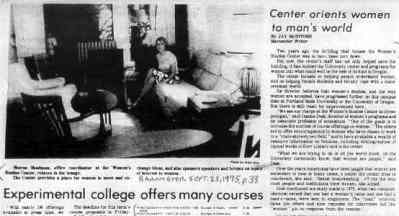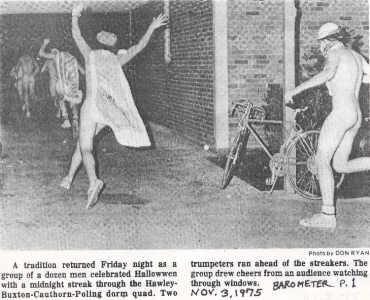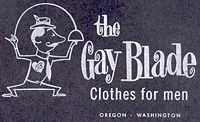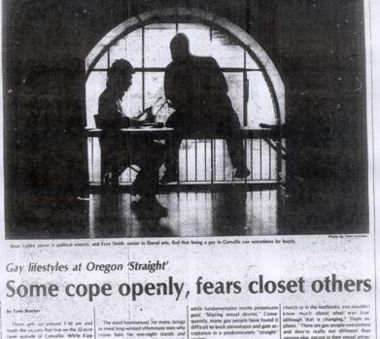Corvallis, Oregon State University gay activism 1969-2004
Under Construction
Corvallis, Oregon State University gay activism: 1969-2004
This exhibit describes post-Stonewall gay activism at Oregon State University in Corvallis, Oregon and events that motivated the formation of the first officially recognized gay student group at OSU in 1976. [1]
Corvallis, Oregon is a traditional rural college town that has been the home of Oregon State University for more than a century. Only recently did the population of Corvallis slightly exceed 50,000 people. OSU has historically attracted conservative students to the research and educational programs in forestry, engineering and agricultural science because of the importance of these fields to the local economy. More liberal students and those seeking a strong liberal arts program have historically favored the University of Oregon, 40 miles to the south in Eugene, Oregon. U of O students used to refer to OSU as "Oregon Straight" or the "cow college" in reference to the cows actually being raised and studied in research programs. OSU students often stereotyped U of O students as being "marijuana smoking hippie peaceniks." Therefore, it was surprising that the formation of a gay student group at OSU in 1976 initially drew little attention from the predominantly straight and anti-gay Christian Republican students.
Gay marriage issue 1976
A 1976 Corvallis, Oregon newspaper story "Gay women: Coming out of the closet in Corvallis, 'Now I want to marry this woman,'" sparked numerous angry letters to the editor and a few threatening to cancel their newspaper subscription. One of the women profiled in the newspaper story also came out in a letter to the editor of her student newspaper. She was active in forming gay women's groups at Oregon State University. [2] [3]
Although the woman profiled in the newspaper story considered gay marriage to be an emotional feeling that was abstract and unthinkable to actually do, an OSU graduate student Thomas Kraemer had been inspired by the gay marriage activism of Rev. Troy Perry and University of Minnesota law student Jack Baker, who took his marriage case to the U.S. Supreme Court and lost in 1972. Kraemer was a charter member of the first officially recognized student group at Oregon State University in 1976 after having participated in Jack Baker's F.R.E.E. (Fight Repression of Erotic Expression) gay liberation group when he was an undergraduate at the University of Minnesota between 1969 and 1975. At that time, most gay activists dismissed the idea of gay marriage as being contrary to the goals of both sexual and gay liberation. [4]
Benton County, the home of Corvallis, Oregon, briefly approved of the granting of gay marriage licenses until pressure from state lawmakers stopped them. A few moths later, citizens banned same-sex marriages with a constitutional amendment in fall of 2004. The ballot measure was sponsored by Republicans as part of President George W. Bush's national reelection strategy.
Exhibit Pages:
- Oregon State University gay students 1908-2010 (under construction)
- Gay Oregon Professor W. Dorr Legg 1935 (under construction)
Timeline:
The creation of an officially recognized gay student group at Oregon State University in 1976 was inspired by similar types of student activism at OSU and other universities. Below is a timeline of key events which influenced the history of OSU gay student groups. [15] [16]
October 1964
University of California Berkeley students start the "Free Speech Movement." Longtime Corvallis, Oregon resident, Dunbar Aitkens, is a participant. [17]
April 1967
Columbia University (New York) officially recognizes the "Student Homophile League" as a student group. [18] [19]
June 1969
Stonewall Inn riot in New York City marks a shift from the older generation of conservative homophile activists to a younger, more militant type of gay activist. [18] [19]
October 1969
University of Minnesota officially recognizes a student club for "gays and sympathizers" called F.R.E.E. (Fight Repression of Erotic Expression). University of Minnesota's Board of Regents tighten club recognition policy in response. [18] [19]
March 1970
University of California Berkeley students stage "gay power" demonstrations and guerrilla theater skits. Longtime Corvallis, Oregon resident, Dunbar Aitkens, is arrested for doing with another man in public what heterosexual couples regularly do in public without being arrested. [20]
May 1970
University of Minnesota F.R.E.E. group issues press release to announce that Jack Baker and Michael McConnell will be applying for a marriage license. Minnesota marriage law does not specify gender. University of Minnesota's Board of Regents vote to withdraw a librarian job offer from Michael McConnell in response to his marriage announcement. [18] [19]
July 1970
University of Nebraska approves Prof. Louis Compton's homophile studies course. [18] [19]
April, 1971
University of Minnesota, openly gay, law student Jack Baker is elected to his first of two terms as student body president. [18] [19]
May 1971
Oregon repeals the state sodomy law as part of a comprehensive overhaul of blue laws. (Prior to this legislation, both oral and anal sex was illegal in Oregon for both heterosexuals and homosexuals.) [18] [19]
June 1971
Columbia University Students protest the college president and black student group's claim that gays are not a legitimate minority. [18] [19]
July 1971
University of Kansas refuses to recognize gay student group. Famous civil rights attorney William Kunstler agrees to take the case, but loses it on appeal when the Supreme Court refuses to hear the case. [18] [19]
October 1972
University of Minnesota law student Jack Baker has his marriage license revoked by a U.S. Supreme Court ruling that said his appeal was "dismissed for want of substantial federal question." The court essentially said that marriages are defined by state and not federal laws. [18] [19]
January 1973
Oregon school teacher Peggy Burton, who had been fired for being a lesbian, wins in federal court, but loses two years later when the Supreme Court refuses to hear the case. [18] [19]
January 1973
Oregon State University Women's Study Center opens as a six month experiment. The Women's Center is a success and it permanently occupies an old building that was about to be demolished. [21] [18] [19]
December 1973
American Psychiatric Association votes to remove homosexuality from the official list of mental disorders. Today, coercive medical treatments that attempt to change a person's sexual orientation have been banned by all major health organizations for being unethical. [18] [19]
Campus ex-gay groups predated gay-friendly student groups. These groups were usually led by a campus minister who wanted to "help" homosexual students become straight via prayer and unethical psychotherapy. Today, several Corvallis churches are still sponsoring ex-gay groups on campus. Ex-gays typically settle for celibacy because most admit to retaining their same-sex desires for ever.
June 1974
Portland, Oregon and Los Angeles police are caught illegally keeping secret files on citizens they suspect of being homosexual. Police defend their actions as needed to fight "terrorism." [18] [19]
December 1974
Portland, Oregon city council votes 3-2 to ban anti-gay discrimination in municipal employment. [18] [19]
June 1975
University of Oregon journalism graduate, Randy Shilts, is hired as a reporter for The Advocate (then a national gay newspaper) by the editor John Preston. Both men later become well known gay authors. [18] [19]
October 1975
Oregon State University Experimental College classes on homosexuality included: "Gay Women's Consciousness Raising" (Instructor: Peggy Jo Nulsen); "FREE 2 B U.N. ME!" (Instructors: Steve Rowe and Dunbar Aitkens of 1460 SW 'A' Avenue); and "Sexual Stereotypes in the Bible" (Instructor: Eric Landau, who represented the then anti-gay campus religious organization Westminster House) [22]
October 1975
Oregon State University Black Cultural Center officially opens at 2320 NW Monroe. [23]
November 1975
Front page of Barometer features the resignation of the legendary Oregon State University football coach and soon to be athletic director, Dee Andros, directly above a photograph of naked OSU streakers. [24]
January 1976
Oregon State University student newspaper, the Barometer, prints an editorial by managing editor Bob Goldstein defending the Corvallis Gazette-Times newspaper's two-page long article featuring lesbians who wanted to get married. The paper was flooded with angry letters and subscription cancellations for just mentioning homosexuality in a so-called "family newspaper." [25] [26] A letter to the editor by longtime Corvallis, Oregon resident Dunbar Aitkens and Steve Rowe praises the Barometer's position, but student John Wilkins writes in to accuse the editors of having poor judgment and no values. [27] [28] One of the women profiled in the article came out in a letter to the editor of her student newspaper and she was active in early gay women's groups at Oregon State University.
March 1976
Oregon State University Native American Longhouse is dedicated March 23, 1976 in a blessing ceremony led by Gilbert Walking Bull. [29]
March 1976
Oregon State University announces that tuition will be $179 per term ($240 per term including incidental fees such as $16.50 for health insurance). Dormitory room and board (with 19 meals per week plan) in Weatherford Hall is projected to cost $1,140 per school year. Typical student jobs pay less than two dollars per hour. [30]
April 1976
Oregon State University Barometer April Fools Day edition includes an advice column headlined, "Lassie not gay." The column's "Mr. Answer" claims that the rumors about the popular TV dogs Lassie and Rin Tin Tin being married to each other are not true. [31]
April 1976
Oregon State University student projectionist refuses to show the sexually graphic movie "Emmanuelle" because it violated his Christian values. He ends up instead showing the violent and bloody movie "Dirty Harry," starring Clint Eastwood. The hypocrisy of this is pointed out in a letter to the editor by longtime Corvallis resident Dunbar Aitkens. [32]
May 1976
Ronald Reagan holds a rally on the Oregon State University campus while running against President Gerald Ford in the Oregon Republican Primary. Reagan does not win the presidency until 1980. President Reagan was highly criticized in the 1980s for his delayed reaction to the AIDS tragedy. [33]
September 1976
A print ad for "The Gay Parfait" restaurant and ice cream parlor at 340 N.W. 5th Steet appears in the Barometer. Also located in downtown Corvallis was a men's clothing store named "The Gay Blade." Both businesses eventually dropped the word "gay" from their names as "gay" became commonly associated with being homosexual. [34]
September 1976
National Organization of Women (NOW) chapter is organized in Corvallis. [35]
October 1976
Oregon State University black cultural center is vandalized and a burning cross is placed on their front lawn. Several students are caught and the university president gives them an "unspecified punishment," which upsets many people on campus. [36]
October 1976
Society for the Advancement of Women (SAW) is denied funding by the student council. [37]
October 1976
Oregon State University Barometer editor, Bob Goldstein, writes an editorial on sex change operations titled "New type of sexism." This is the first mention of transsexual or transgendered people in the Barometer. [38]
November 1976
Oregon State University gay students meet on November 4 in the Women's Center to form the first officially recognized gay student group. The weekly meeting agendas are discreetly printed with tiny 6-point type in the Barometer student newspaper's "Campus" calendar section. The microfilm copies are nearly illegible, but the complete text of each meeting announcement is as follows:
November 4, 1976
Center for Women's Studies has an open discussion to ascertain the needs of gay people. How does a person deal with "his-her" homosexuality-bisexuality in this community? 7 P.M. [39]
November 11, 1976
Gay men and women meeting - 7 PM - Center for Women's Studies. Discuss needs of gay men and women in this community. How does one deal with "his-her" homosexuality-bisexuality? [40]
November 18, 1976
Gay people - 7 PM - Center for Women's Studies. Meet to plan social and educational activities. [41]
December 2, 1976
Gay people - 7 PM Center for Women's Studies. Discuss organization and future activities. [42]
April 1977
Oregon's Multnomah County Medical Association polls Portland area doctors and finds that 80 percent would refuse to treat gay patients. This problem became even worse when AIDS struck in the 1980s. Medical professionals often refused to treat gay men due to the fear of getting AIDS. [18] [19]
June 1977
Eugene, Oregon's city council votes 5-3 to make it illegal to discriminate against homosexuals. [18] [19]
May 1978
Eugene, Oregon citizens vote (61 percent to 39 percent) to repeal the city's ordinance protecting homosexuals from discrimination. Local anti-gay leaders rejected help from singer Anita Bryant's national religious organization which was lobbying to repeal similar laws in other cities across the country. Instead of trying to convince Eugene voters with a religious based argument, opponents of the ordinance falsely claimed it was a "special right," which was not needed because homosexuals were already protected under law. In 2004, backers of the anti-gay marriage amendment successfully used the same false argument with Oregon voters. [18] [19]
May 1978
Oregon congressman U.S. Rep. James Weaver of Eugene is targeted for defeat by national Republican groups because he sponsored a federal gay non-discrimination act. Political operatives attended church meetings and smeared Weaver by calling him "anti-Christian" and "anti-family." [18] [19]
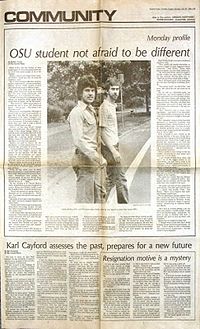
May 1982
Eddie Hickey's GPA funding request for the 1982-1983 school-year of $100 culminated unsuccessfully in 1982 after a heated campus-wide debate. [43] The $100 request was out of a total student incidental fees budget of over $4,400,000. ($87.78 per term incidental fees times 3 terms times 16,743 students enrolled [44] (See "OSU gay funding defeat 1982" (8/2/06) and OSU 1982 GT Eddie Hickey article (10/1/07))
April 1984
The discovery of HIV being the likely cause of AIDS is announced. Many people associated with Oregon State University died of AIDS. Anti-gay politicians cruelly exploited the AIDS tragedy to demonize homosexuals and to justify the firing of gay workers. Before a test for HIV was developed, gay men were rationally barred from donating blood. Although today the government's own medical advisory panel sees no reason for keeping this ban other than prejudice, even celibate and HIV negative gay men are still barred from donating blood. [18] [19]
May 9, 1984
OSU Newsmagazine in-Edition, May 9, 1984 cover story by Tami Brucker, "Lifestyles, Happy and Gay at OSU" was inserted in the official student newspaper The Daily Barometer. The feature article "Gay lifestyles at Oregon 'Straight,' Some cope openly, fears closet others" did an astounding job covering many aspects of "gay lifestyles" at Oregon State University. The article also summarized the history of Eddie Hickey who lobbied the student government to fund the gay student group and later died from AIDS. In 2000, the Associated Press AP stylebook amended the gay entry so that it specifically discouraged references to a "gay lifestyle." (See "OSU gay lifestyles 1984" (7/23/06))
November 1999
Oregon State University "Lesbian, Gay, Bisexual and Transgendered Alliance" (LGBTA) votes (10-8) to change its name to the "Rainbow Continuum" in order to be more inclusive of all sexual and gender identities. Many group members preferred the name "Queers and Allies" (Q & A) as a way of taking back the word "queer" from people who use it as an insult. [45]
March 2001
Oregon State University Student Fees committee voted (7-0) to approve funding for the "Queer Resource Center." Opponents of the QRC vowed to continue their fight to stop this new cultural center. The QRC is housed in a former closet of the Women's Center. [46]
October 2004
New "Pride Center" opens at 1553 SW 'A' Avenue. OSU President Ed Ray cut the ribbon at the official opening on "National Coming Out Day," October 11, 2004. [47]
References
- ↑ Thomas Kraemer, "OSU first gay student group," thomaskraemer.blogspot.com posted May 14, 2008, accessed Jan. 30, 2010
- ↑ Anne Wood, "Gay women: Coming out of the closet in Corvallis, 'Now I want to marry this woman,'" Gazette-Times (Corvallis, Oregon), Jan. 9, 1976, p. 7-8
- ↑ Thomas Kraemer, "Gay 1976 newspaper controversy," thomaskraemer.blogspot.com posted May 3, 2006, accessed Jan. 30, 2010
- ↑ Thomas Kraemer, "Life Magazine gay marriage 1971," thomaskraemer.blogspot.com posted Nov. 20, 2008, accessed Jan. 30, 2010
- ↑ Thomas Kraemer, "Gay OSU Beavers history," thomaskraemer.blogspot.com posted Jan. 28, 2009, accessed Feb. 1, 2010
- ↑ Thomas Kraemer, "OSU gay sports panel," thomaskraemer.blogspot.com posted Oct. 17, 2008, accessed Feb. 1, 2010
- ↑ Thomas Kraemer, "OSU Esera Tuaolo gay football star," thomaskraemer.blogspot.com posted Aug. 12, 2006, accessed Feb. 1, 2010
- ↑ Thomas Kraemer, "Gay OSU Beavers history," thomaskraemer.blogspot.com posted Jan. 28, 2009, accessed Feb. 1, 2010
- ↑ Thomas Kraemer, "OSU gay football player 1908," thomaskraemer.blogspot.com posted Jun. 19, 2008, accessed Feb. 1, 2010
- ↑ Thomas Kraemer, "Gay Oregon Professor 1935," thomaskraemer.blogspot.com posted Sep. 16, 2006, accessed Feb. 1, 2010
- ↑ Thomas Kraemer, "Gay OSU Beavers history," thomaskraemer.blogspot.com posted Jan. 28, 2009, accessed Feb. 1, 2010
- ↑ Thomas Kraemer, "OSU Gay Sheep NY Times," thomaskraemer.blogspot.com posted Feb. 7, 2007, accessed Feb. 1, 2010
- ↑ Thomas Kraemer, "Gay OSU Beavers history," thomaskraemer.blogspot.com posted Jan. 28, 2009, accessed Feb. 1, 2010
- ↑ Thomas Kraemer, "OSU gay fruit fly sex research," thomaskraemer.blogspot.com posted Sep. 16, 2006, accessed Feb. 1, 2010
- ↑ Thomas Kraemer, "OSU gay student group history," thomaskraemer.blogspot.com posted May 3, 2006, accessed Jan. 30, 2010
- ↑ Thomas Kraemer, "OSU queer history month speech," thomaskraemer.blogspot.com posted Sep. 30, 2006, accessed Jan. 30, 2010
- ↑ Meredith May, "40 years on, Free Speechers talk all they want," San Francisco Chronicle, Oct. 11, 2004, p. B-5
- ↑ 18.00 18.01 18.02 18.03 18.04 18.05 18.06 18.07 18.08 18.09 18.10 18.11 18.12 18.13 18.14 18.15 18.16 18.17 18.18 18.19 18.20 Mark Thompson, editor, "Long road to freedom: The Advocate history of the gay and lesbian movement," 1994
- ↑ 19.00 19.01 19.02 19.03 19.04 19.05 19.06 19.07 19.08 19.09 19.10 19.11 19.12 19.13 19.14 19.15 19.16 19.17 19.18 19.19 19.20 Dudley Clendinen and Adam Nagourney, "Out for good: The struggle to build a gay rights movement in America," 1999
- ↑ "Social Protest Collection," Container 8: Gay Movement (BANC MSS 86/157c), The Bancroft Library, University of California, Berkeley, as referenced by "Gay Bears: Campus Police" sunsite3.berkeley.edu/gaybears/police accessed July 14, 2005
- ↑ Barometer, Sept. 25, 1975, p. 33
- ↑ Barometer, Oct. 2, 1975, p. 10-15 and May 11, 1976, p.2
- ↑ Barometer, Sept. 25, 1975, p. 44
- ↑ Barometer, Nov. 3, 1975, p. 1
- ↑ Barometer, Jan. 14, 1976, p. 4
- ↑ Anne Wood, "Gay women: Coming out of the closet in Corvallis, 'Now I want to marry this woman,'" Corvallis Gazette-Times, Jan. 9, 1976, p. 7-8
- ↑ Barometer, Jan. 22, 1976, p. 4
- ↑ Corvallis Gazette-Times, Jan. 20, 1976, p. 4
- ↑ Barometer, Apr. 5, 1976, p. 5
- ↑ Barometer, Feb. 23, 1976, p. 1 and Mar. 31, 1976, p. 1
- ↑ Barometer, Apr. 1, 1976, p. 15
- ↑ Barometer, Apr. 27, 1976, p. 1, Apr. 28, p. 4, Apr. 29, p. 5, Apr. 30, p. 3
- ↑ Barometer, May 24, 1976, p. 1
- ↑ Barometer, Sep. 22, 1976, p. 39
- ↑ Barometer, Sep. 30, 1976, p. 10
- ↑ Barometer, Oct. 20, 1976, p. 1, Oct. 21, p. 4, Oct. 22, p. 1, Oct. 25, p. 1, 11
- ↑ Barometer, Oct. 20, 1976, p. 1
- ↑ Barometer, Oct. 13, 1976, p. 4
- ↑ Barometer, Nov. 4, 1976, p. 15
- ↑ Barometer, Nov. 10-11, 1976, p. 11
- ↑ Barometer, Nov. 18, 1976, p. 11
- ↑ Barometer, Dec. 2, 1976 p. 15
- ↑ Patty Keiper, "Arbitration vote defeats GPA request," Barometer, May 12, 1982, p.1
- ↑ Barometer, Oct. 28, 1982
- ↑ Barometer, November 3, 1999, p. 1
- ↑ Barometer, Mar. 15, 2001, p. 1
- ↑ Barometer, October 12, 2004, p. 1
Contact
Thomas Kraemer
thomaskraemer.blogspot.com
outhistory@gc.cuny.edu
Categories
